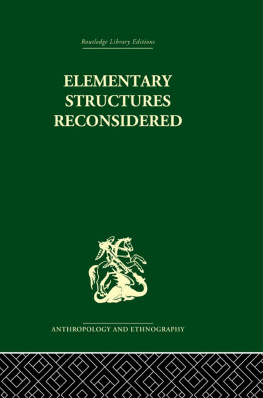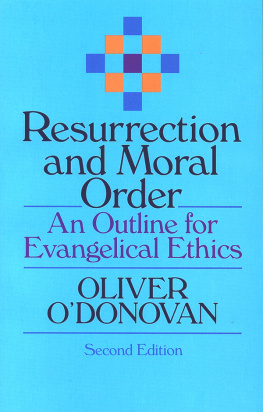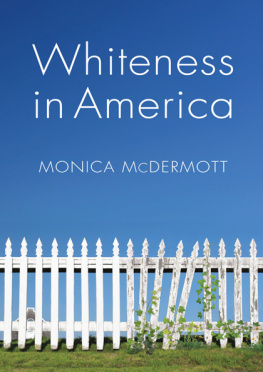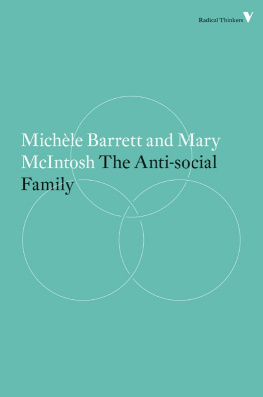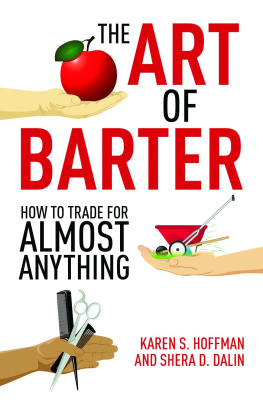Routledge Library Editions
ELEMENTARY STRUCTURES RECONSIDERED

ANTHROPOLOGY AND ETHNOGRAPHY
Routledge Library Editions
Anthropology and Ethnography
FAMILY & KINSHIP In 7 Volumes
| I | Three Styles in the Study of Kinship | Barnes |
| II | Kinship and the Social Order | Fortes |
| III | Comparative Studies in Kinship | Goody |
| IV | Elementary Structures Reconsidered | Korn |
| V | Remarks and Inventions | Needham |
| VI | Rethinking Kinship and Marriage | Needham |
| VII | A West Country Village: Ashworthy | Williams |

First published in 1973
Reprinted in 2004 by
Routledge
2 Park Square, Milton Park, Abingdon, Oxon, OX14 4RN
Transferred to Digital Printing 2009
Routledge is an imprint of the Taylor & Francis Group
1973 Francis Korn
All rights reserved. No part of this book may be reprinted or reproduced or utilized in any form or by any electronic, mechanical, or other means, now known or hereafter invented, including photocopying and recording, or in any information storage or retrieval system, without permission in writing from the publishers.
The publishers have made every effort to contact authors/copyright holders of the works reprinted in Routledge Library Editions Anthropology and Ethnography. This has not been possible in every case, however, and we would welcome correspondence from those individuals/companies we have been unable to trace.
These reprints are taken from original copies of each book. In many cases the condition of these originals is not perfect. The publisher has gone to great lengths to ensure the quality of these reprints, but wishes to point out that certain characteristics of the original copies will, of necessity, be apparent in reprints thereof.
British Library Cataloguing in Publication Data
A CIP catalogue record for this book is available from the British Library
Elementary Structures Reconsidered
ISBN 0-415-32556-0 (set)
ISBN 0-415-33011-4
ISBN 978-1-136-53584-0 (ePub)
Miniset: Family & Kinship
Series: Routledge Library Editions Anthropology and Ethnography
Elementary Structures Reconsidered
Lvi-Strauss on Kinship
Francis Korn

TAVISTOCK PUBLICATIONS
First published in 1973
By Tavistock Publications Limited
11 New Fetter Lane, London 4EE
Printed in Great Britain
By T. & A. Constable Ltd Edinburgh
Francis Korn 1973
SBN 422 74210 4
To Klaus
Figures
Tables
To publish a critique of a famous book written by a famous social anthropologist is perhaps a hardy undertaking. It is a kind of enterprise, at any rate, that calls apparently for a special justification. The present monograph has been written, nevertheless, in the conviction that to analyse what has been done, particularly if this is theoretically in vogue, can be just as useful for the understanding of social facts as to attempt something entirely novel.
I desire to thank those who helped me in maintaining this conviction during the writing of this book. In the course of the three years in which I composed the analyses presented here, I had the privilege of working under the guidance of Dr Rodney Needham at the University of Oxford. I received then not only the benefit of his extensive published work relating to my subject but his personal instruction and constant help in solving all sorts of technical, theoretical, and practical problems. This book could not possibly have been the same without his invaluable aid.
Lic. Ada Korn was so kind as to criticize my own logic, particularly in . Mrs P. Grant gave me unfailing friendly assistance which did a great deal to leave me free to write.
Dr E. R. Leach, the foremost anthropological exponent of Lvi-Strausss views, and Dr P. G. Rivire read and commented on the manuscript.
The work was begun under the auspices of the ConsejoNacional de Investigaciones Cientficas y Tcnicas (Argentina), which awarded me, while I was a lecturer in the methodology of social research at the National University of Buenos Aires, an external scholarship in order to pursue my researches in England.
F. K.
University of Oxford
Parts of this book have previously been published in other places.
The following bodies are thanked for permission to reprint.
The American Anthropological Association, in respect of The Logic of some Concepts in Lvi-Strauss, American Anthropologist, 71 (1969): 70-1. The Koninklijk Instituut voor Taal-, Land- en Volkenkunde: The Analysis of the Term Model in some of Lvi-Strausss Works, Bijdragen tot de Taal-, Land- en Volkenkunde, 125 (1969): I-II; Terminology and Structure: The Dieri Case, Bijdragen tot de Taal-, Land- en Volkenkunde, 127 (1971): 39-81. Tavistock Publications Limited and the Association of Social Anthropologists of the Commonwealth: A Question of Preferences: The Iatml Case, in Rodney Needham, ed., Rethinking Kinship and Marriage, ASA Monographs II (London: Tavistock Publications, 1971), (pp. 99-132). The Royal Anthropological Institute of Great Britain and Ireland: Permutation Models and Prescriptive Systems: The Tarau Case (in collaboration with Rodney Needham), Man, n.s., 5 (1970): 393-420.
The diagram on p. 91 (Figure 21) is reprinted from Naven (second edition) by Gregory Bateson, with the permission of the publishers, Stanford University Press. 1958 by the Board of Trustees of the Leland Stanford Junior University.
Les Structures lmentaires de la parent, by Claude Lvi-Strauss, has acquired the stature of a classic in social anthropology. In the present monograph I wish to examine its scientific claims to this reputation.
Lvi-Strausss work is considered a remarkable feat of analysis not only by social anthropologists, but also by a surprising number of writers in other fields. To cite the opinion of one of the most prominent modern psychologists, for Piaget the anthropological structuralism of Lvi-Strauss presents an exemplary character and constitutes the most striking model neither functional nor genetic nor historical, but deductive that has been employed in an empirical human science (Piaget 1968: 90). For Boudon, similarly, Lvi-Strausss treatment of marriage rules constitutes an exact, general, falsifiable theory (1968: 203), and the scientific importance of Lvi-Strausss discoveries in anthropology needs no further demonstration (1968: 10).
For Lvi-Strauss himself, Les Structures lmentaires de la parent is an introduction to a general theory of kinship systems. It is presented as an example in method, and indeed as the last word as far as the explanation of kinship systems is concerned: even if some aspect of the problem treated in the work were developed no new idea would need to be introduced (Lvi-Strauss 1949: xi).
I
Les Structures lmentaires de la parent was first published in 1949. The book constituted, according to Lvi-Strauss, a stage in his effort to produce a sort of inventory of mental constraints, an attempt to reduce the arbitrary to an order, to discover a necessity immanent in an illusion of liberty. He chose kinship, he later explained, because it was a domain which might seem at first to be characterized by its incoherent and contingent character, and he tried to demonstrate that it was possible to reduce this domain to a very small number of significant propositions (1963a: 630).
Next page
